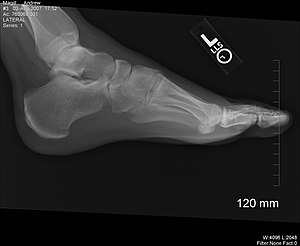 |
| (Photo credit: Wikipedia) |
- Rest
- Ice
- Over-the-counter pain medication
- Running downhill or on a slanted or uneven surface
- Running in footwear that lacks the proper cushioning, or is worn beyond usefulness
- Rigorous sports activity
- Running too hard, fast and long to avoid stress overload
Shin splints can be avoided or prevented from returning by paying close attention to the surfaces you walk or run on, the condition of your shoes and adequate warm up activity. If running is the cause of your shin splints, there is no need to completely give up the activity. Limit the time spent and intensity of running. Change to a more mild form of aerobic exercise such as swimming or bicycling until you are healed enough to resume regular activity. Return to normal routine slowly and with proper conditioning and take a couple of days off running and do some strength training, including a workout for your toes. Slowly rise up on your toes, and slowly lower to the floor. Repeating this ten times can gradually build up strength.
Call Dr. Blaakman at (877) 941-3338 if your pain persists. He has great treatment options just right for getting you off the round-a-bout of pain and on the road to recovery.
References:
http://www.upstatefootcare.com/new-patients/video-library/
http://www.mayoclinic.com/health/shin-splints/DS00271












